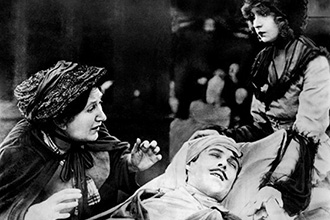College of Arts and Sciences Newsroom

Birth of Whose Nation?
An Emmy Award-winning independent filmmaker will join a panel of University of Dayton faculty and staff to discuss the controversial 1915 cinematic landmark, The Birth of a Nation, and its historical significance to modern U.S. race relations.
“Birth of Whose Nation? Black and White in America” will feature clips from the film and a panel discussion at 7 p.m. Wednesday, March 8, in the Sears Recital Hall of the Jesse Philips Humanities Center on campus. The event is free and open to the public.
The panel is highlighted by Dante James, president of Dayton-based Black Pearl Media Works, who served as adjunct faculty at the University from 2014 to 2016. In 2006, James won an Emmy for his work as series producer on the critically acclaimed PBS documentary series, Slavery and the Making of America.
The panel will also include Lawrence Burnley, University vice president for diversity and inclusion; Anthony Smith, associate professor of religious studies; Hsuan Tsen, art and design lecturer; and Denise James, director of the women’s and gender studies program.
Directed by D.W. Griffith and starring Springfield, Ohio, native Lillian Gish, The Birth of a Nation is an epic, three-hour silent drama that chronicles the relationship of two families fighting on opposite sides of the American Civil War. The film depicts the assassination of President Abraham Lincoln and the birth of the Ku Klux Klan.
The film endorsed slavery, championed the KKK as a heroic force and depicted black Americans — some portrayed by white actors in blackface — as unintelligent and sexually aggressive toward white women. It drew protests in some cities and was banned in others.
“Seeing these racist images on the screen as a grand spectacle, with a live band, had a major impact on perceptions of race within the white community,” Dante James said. “These images were, in some cases, the only connection many whites had to black Americans.”
James said Griffith’s film also was major leap forward in terms of production techniques and values. It pioneered the use of close-ups and fade-outs, and featured carefully staged battle sequences with hundreds of extras.
“Griffiths initiated color tinting and the technique of building a story to an exciting climax,” James said. “He coupled his interpretation of historical events with fiction, and he incorporated a musical score written specifically for the film and performed by a live orchestra. These were all new to film.”
Smith, the religious studies professor, said The Birth of a Nation harnessed the new medium of film in the early 20th century to a white Christian fantasy of the U.S. “The film ends with the appearance of Jesus, as if to bless the reconciliation of North and South through the violent repression of African-Americans,” he said.
Smith said the film blended Griffith’s skill as a filmmaker with a highly racialized vision of the nation.
“The Birth of a Nation helped to legitimize movies as a mainstream cultural practice and gave new popular expression to a racist understanding of the American community,” he said.
The film stirred new controversy in 1992, when the Library of Congress selected it for preservation in the National Film Registry, and again in 1998 when it was voted one of the “Top 100 American Films” by the American Film Institute.
Ellen Fleischmann, University of Dayton Alumni Chair in Humanities, is sponsoring the panel. She said it was first considered in 2015 to mark the film’s centennial. Since then, the topic has become increasingly timely — particularly in the wake of the June 2015 church shooting in Charleston, South Carolina, as well as the rise of the Black Lives Matter movement in response to police killings of black people.
“It became extremely important to link this 100-year-old film to the present,” Fleischmann said.
James hopes the event will motivate the University community to think about race relations and what can be done, individually and collectively, to confront and deconstruct all forms of intolerance.
“As a society, we face issues of race, class, gender, sexual orientation and religion,” he said. “The list goes on, but nothing will happen until everyone makes a commitment to do whatever they can to deal with intolerance. We all have to strive to be the best that humanity has to offer.”
- Dave Larsen, communication coordinator, College of Arts and Sciences
Photo, top of page: (l to r) Josephine Crowell, Henry B. Walthall, and Lillian Gish in the 1915 film The Birth of a Nation. This image is in the public domain in the United States.
